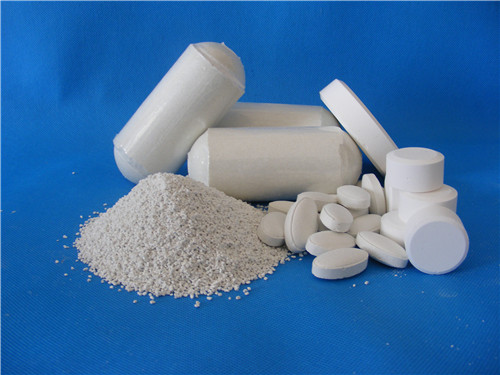Homepage / News Details
Unveiling the Multi-Faceted Applications of Calcium Hypochlorite
- Categroy:News
- Author:
- Origin:
- Release Time:2024-03-25 09:19
- Views:
【Summary】In today's rapidly evolving world, the importance of effective disinfection and sanitation has never been more prominent. Among the plethora of disinfectants available, calcium hypochlorite stands out as a powerful and versatile solution. This chemical compound, commonly used as a disinfectant, Pool Cleaner, and even in disaster relief efforts, has earned its place as a crucial agent in various industries. In this article, we'll delve into the myriad uses of calcium hypochlorite, shedding light on its significance in today's health and safety landscape. 1. Pool Maintenance: Keeping Recreational Spaces Safe and Clean One of the most common applications of calcium hypochlorite is in swimming pool maintenance. Its ability to effectively kill harmful bacteria, viruses, and algae makes it an essential component of pool water treatment. Calcium hypochlorite releases chlorine into the water, ensuring that pools remain safe and inviting for swimmers. Its high chlorine content makes it a cost-effective choice for commercial and residential pool owners alike, helping to maintain crystal-clear water. 2. Water Purification: Safeguarding Communities In regions where access to clean drinking water is a challenge, calcium hypochlorite plays a pivotal role in water purification. Municipal water treatment facilities use it to disinfect drinking water, making it safe for consumption. By eradicating harmful microorganisms and pathogens, calcium hypochlorite contributes to improved public health, reducing the risk of waterborne diseases. 3. Disaster Relief: A Rapid Response Solution During natural disasters such as hurricanes, earthquakes, or floods, access to clean water can become severely limited. Calcium hypochlorite tablets are used to provide emergency water disinfection. A small tablet can purify a significant amount of water, making it a lifesaver in situations where clean water sources are scarce. Non-governmental organizations and disaster relief teams rely on calcium hypochlorite to ensure that affected communities have access to safe drinking water in times of crisis. 4. Medical Facilities: Maintaining Sterile Environments In healthcare settings, maintaining a sterile environment is paramount. Calcium hypochlorite is used to disinfect surfaces, equipment, and even medical waste. Its broad-spectrum disinfecting properties help healthcare professionals reduce the risk of infections, safeguarding both patients and staff. 5. Food Industry: Ensuring Safe Consumption The food industry relies on calcium hypochlorite for disinfection and sanitation purposes. From sanitizing food processing equipment to disinfecting fruits and vegetables, this compound helps ensure that the food we consume is safe and free from harmful pathogens. It plays a vital role in reducing foodborne illnesses and ensuring food safety standards are met. 6. Sanitization in Education: Protecting Students and Staff Schools and educational institutions are increasingly turning to calcium hypochlorite for sanitation. It helps prevent the spread of contagious diseases in crowded environments. By regularly disinfecting classrooms, hallways, and common areas, it contributes to a safer learning environment for students and educators. As we navigate the challenges of the modern world, Calcium Hypochlorite emerges as a versatile and indispensable tool in safeguarding public health, ensuring clean water access, and maintaining sanitary conditions across various industries. Its role in pool maintenance, disaster relief, healthcare, and more showcases its adaptability and efficacy. Calcium hypochlorite continues to be a crucial ally in our ongoing battle against diseases and contaminants, promising a safer and healthier future for all. To reap the full benefits of this remarkable chemical compound, it’s essential to handle it with care and follow recommended safety guidelines.
Unveiling the Multi-Faceted Applications of Calcium Hypochlorite
【Summary】In today's rapidly evolving world, the importance of effective disinfection and sanitation has never been more prominent. Among the plethora of disinfectants available, calcium hypochlorite stands out as a powerful and versatile solution. This chemical compound, commonly used as a disinfectant, Pool Cleaner, and even in disaster relief efforts, has earned its place as a crucial agent in various industries. In this article, we'll delve into the myriad uses of calcium hypochlorite, shedding light on its significance in today's health and safety landscape.
1. Pool Maintenance: Keeping Recreational Spaces Safe and Clean
One of the most common applications of calcium hypochlorite is in swimming pool maintenance. Its ability to effectively kill harmful bacteria, viruses, and algae makes it an essential component of pool water treatment. Calcium hypochlorite releases chlorine into the water, ensuring that pools remain safe and inviting for swimmers. Its high chlorine content makes it a cost-effective choice for commercial and residential pool owners alike, helping to maintain crystal-clear water.
2. Water Purification: Safeguarding Communities
In regions where access to clean drinking water is a challenge, calcium hypochlorite plays a pivotal role in water purification. Municipal water treatment facilities use it to disinfect drinking water, making it safe for consumption. By eradicating harmful microorganisms and pathogens, calcium hypochlorite contributes to improved public health, reducing the risk of waterborne diseases.
3. Disaster Relief: A Rapid Response Solution
During natural disasters such as hurricanes, earthquakes, or floods, access to clean water can become severely limited. Calcium hypochlorite tablets are used to provide emergency water disinfection. A small tablet can purify a significant amount of water, making it a lifesaver in situations where clean water sources are scarce. Non-governmental organizations and disaster relief teams rely on calcium hypochlorite to ensure that affected communities have access to safe drinking water in times of crisis.
4. Medical Facilities: Maintaining Sterile Environments
In healthcare settings, maintaining a sterile environment is paramount. Calcium hypochlorite is used to disinfect surfaces, equipment, and even medical waste. Its broad-spectrum disinfecting properties help healthcare professionals reduce the risk of infections, safeguarding both patients and staff.
5. Food Industry: Ensuring Safe Consumption
The food industry relies on calcium hypochlorite for disinfection and sanitation purposes. From sanitizing food processing equipment to disinfecting fruits and vegetables, this compound helps ensure that the food we consume is safe and free from harmful pathogens. It plays a vital role in reducing foodborne illnesses and ensuring food safety standards are met.
6. Sanitization in Education: Protecting Students and Staff
Schools and educational institutions are increasingly turning to calcium hypochlorite for sanitation. It helps prevent the spread of contagious diseases in crowded environments. By regularly disinfecting classrooms, hallways, and common areas, it contributes to a safer learning environment for students and educators.
As we navigate the challenges of the modern world, Calcium Hypochlorite emerges as a versatile and indispensable tool in safeguarding public health, ensuring clean water access, and maintaining sanitary conditions across various industries. Its role in pool maintenance, disaster relief, healthcare, and more showcases its adaptability and efficacy. Calcium hypochlorite continues to be a crucial ally in our ongoing battle against diseases and contaminants, promising a safer and healthier future for all. To reap the full benefits of this remarkable chemical compound, it’s essential to handle it with care and follow recommended safety guidelines.
- Categroy:News
- Author:
- Origin:
- Release Time:2024-03-25 09:19
- Views:

In today's rapidly evolving world, the importance of effective disinfection and sanitation has never been more prominent. Among the plethora of disinfectants available, calcium hypochlorite stands out as a powerful and versatile solution. This chemical compound, commonly used as a disinfectant, Pool Cleaner, and even in disaster relief efforts, has earned its place as a crucial agent in various industries. In this article, we'll delve into the myriad uses of calcium hypochlorite, shedding light on its significance in today's health and safety landscape.
1. Pool Maintenance: Keeping Recreational Spaces Safe and Clean
One of the most common applications of calcium hypochlorite is in swimming pool maintenance. Its ability to effectively kill harmful bacteria, viruses, and algae makes it an essential component of pool water treatment. Calcium hypochlorite releases chlorine into the water, ensuring that pools remain safe and inviting for swimmers. Its high chlorine content makes it a cost-effective choice for commercial and residential pool owners alike, helping to maintain crystal-clear water.
2. Water Purification: Safeguarding Communities
In regions where access to clean drinking water is a challenge, calcium hypochlorite plays a pivotal role in water purification. Municipal water treatment facilities use it to disinfect drinking water, making it safe for consumption. By eradicating harmful microorganisms and pathogens, calcium hypochlorite contributes to improved public health, reducing the risk of waterborne diseases.
3. Disaster Relief: A Rapid Response Solution
During natural disasters such as hurricanes, earthquakes, or floods, access to clean water can become severely limited. Calcium hypochlorite tablets are used to provide emergency water disinfection. A small tablet can purify a significant amount of water, making it a lifesaver in situations where clean water sources are scarce. Non-governmental organizations and disaster relief teams rely on calcium hypochlorite to ensure that affected communities have access to safe drinking water in times of crisis.
4. Medical Facilities: Maintaining Sterile Environments
In healthcare settings, maintaining a sterile environment is paramount. Calcium hypochlorite is used to disinfect surfaces, equipment, and even medical waste. Its broad-spectrum disinfecting properties help healthcare professionals reduce the risk of infections, safeguarding both patients and staff.
5. Food Industry: Ensuring Safe Consumption
The food industry relies on calcium hypochlorite for disinfection and sanitation purposes. From sanitizing food processing equipment to disinfecting fruits and vegetables, this compound helps ensure that the food we consume is safe and free from harmful pathogens. It plays a vital role in reducing foodborne illnesses and ensuring food safety standards are met.
6. Sanitization in Education: Protecting Students and Staff
Schools and educational institutions are increasingly turning to calcium hypochlorite for sanitation. It helps prevent the spread of contagious diseases in crowded environments. By regularly disinfecting classrooms, hallways, and common areas, it contributes to a safer learning environment for students and educators.
As we navigate the challenges of the modern world, Calcium Hypochlorite emerges as a versatile and indispensable tool in safeguarding public health, ensuring clean water access, and maintaining sanitary conditions across various industries. Its role in pool maintenance, disaster relief, healthcare, and more showcases its adaptability and efficacy. Calcium hypochlorite continues to be a crucial ally in our ongoing battle against diseases and contaminants, promising a safer and healthier future for all. To reap the full benefits of this remarkable chemical compound, it’s essential to handle it with care and follow recommended safety guidelines.
Releate News

Time of issue : 2024-04-22 08:56:03

Time of issue : 2024-04-15 16:52:27

Time of issue : 2024-04-09 10:13:04
CONTACT US
PRODUCTS
CALCIUM HYPOCHLORITE
TCCA
SDIC
BCDMH
FEEDBACK
© 1999-2018 北京网站建设有限公司 Copyright © 2012-2022 All Rights Reserved Powered by www.300.cn 冀ICP备12012949号 津公网安备 12010302002173号 Seo tag

